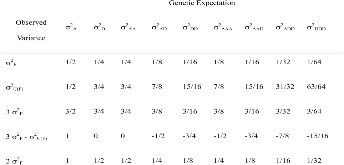Additive and Non-Additive Genetic Variances for Tree Growth in Several Hybrid Poplar Populations and Implications Regarding Breeding Strategy
- Univ. of Minnesota, Duluth, MN (United States)
Populus species (P. deltoides, P. maximowiczii, P. nigra) and their inter-specific hybrids were tested for growth rate over a five year period at four test locations in Minnesota, USA, to estimate genetic variance components. The breeding scheme incorporated recurrent selection of full-sib families of pure species parents, production of F1inter-specific hybrids from selected families, and selection of clones within the F1s. Improvement of yield through time using this scheme is predicated on the assumption that additive effects comprise a significant portion of the total genetic variance. The estimates of additive and non-additive variances reported are not traditional point estimates, because a fully balanced mating design was impossible due to parental incompatibilities which result in incomplete breeding matrices. Instead, bounded estimates, not previously used in tree genetics research, are derived from linear combinations of formulae of genetic expectations observed among-family, among-clone, and environmental variances. Our results suggest that combined family and mass selection would lead to increases in growth rate of 27 % and 47 % per generation in P. deltoides and P. nigra, respectively. Broad sense-based clonal selection within the F1could yield selection responses in excess of 90 % of the mean of such populations. Among-family variance comprised about 1/3 of total genetic variance while within-family variance was always about 2/3 of total genetic variance, regardless of pedigree. With this beind said, the results indicate that recurrent intraspecific selective breeding followed by interspecific hybridization and non-recurrent selection based on broad sense genetic variation would constitute an effective yield improvement strategy.
- Research Organization:
- South Dakota State Univ., Brookings, SD (United States)
- Sponsoring Organization:
- USDOE
- Grant/Contract Number:
- FC36-05GO85041
- OSTI ID:
- 1498989
- Journal Information:
- Silvae Genetica, Vol. 66, Issue 1; ISSN 2509-8934
- Country of Publication:
- United States
- Language:
- English
Web of Science
Estimating genetic gains from alternative breeding strategies for clonal forestry
|
journal | January 1992 |
Genetic analysis of risk in clonal populations of forest trees
|
journal | June 1990 |
Using clonal replicates to explore genetic variation in a perennial plant species
|
journal | November 1988 |
Early rooting of dormant hardwood cuttings of Populus : analysis of quantitative genetics and genotype × environment interactions
|
journal | April 2005 |
The Economics of Rapid Multiplication of Hybrid Poplar Biomass Varieties
|
journal | May 2019 |
Breeding progress and preparedness for mass-scale deployment of perennial lignocellulosic biomass crops switchgrass, miscanthus, willow and poplar
|
journal | October 2018 |
Similar Records
Growth performance of hybrid poplar clones on two agricultural sites with and without early irrigation and fertilization
Role of Osmotic Adjustment in Plant Productivity





